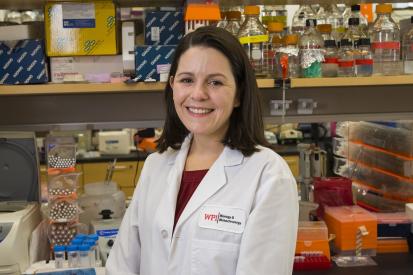

Amity Manning
Work in my lab is focused on defining the cellular mechanisms that maintain genome stability in normal cells and understanding how these pathways are corrupted in cancer cells. Genomic instability is a feature common in cancer that leads to aneuploidy and intra-tumor heterogeneity. Whole chromosome instability (CIN) results from underlying defects in mitotic chromosome segregation and leads to gains and losses of entire whole chromosomes. The ability of CIN cancer cells to ‘shuffle’ their genomic content can lead to gains of oncogenes, loss of tumor suppressors, and promotes tumor cell evolution. The resulting genomic heterogeneity between cells within a single tumor can hamper the identification of effective therapies and promote acquired drug resistance. The existence of genomic instability represents a major difference between cancer cells and the normal cells from which they are derived. As such, manipulation of CIN may represent a point of weakness that can be exploited. Experimental evidence has suggested that both increasing and suppressing CIN may be therapeutically valuable, though the most appropriate mechanisms by which to alter CIN, as well as the cancer contexts where this would be most advantageous remain unclear. Using a combination of molecular and cell biological approaches, together with bioinformatics and imaging techniques, my group aims to identify changes associated with genomic instability in cancer and exploit these changes to identify novel therapeutic targets and enhance cancer cell death. I look forward to working with students both in class and in lab to gain a better understanding of cancer cell biology and to make meaningful contributions to cancer research.

Amity Manning
Work in my lab is focused on defining the cellular mechanisms that maintain genome stability in normal cells and understanding how these pathways are corrupted in cancer cells. Genomic instability is a feature common in cancer that leads to aneuploidy and intra-tumor heterogeneity. Whole chromosome instability (CIN) results from underlying defects in mitotic chromosome segregation and leads to gains and losses of entire whole chromosomes. The ability of CIN cancer cells to ‘shuffle’ their genomic content can lead to gains of oncogenes, loss of tumor suppressors, and promotes tumor cell evolution. The resulting genomic heterogeneity between cells within a single tumor can hamper the identification of effective therapies and promote acquired drug resistance. The existence of genomic instability represents a major difference between cancer cells and the normal cells from which they are derived. As such, manipulation of CIN may represent a point of weakness that can be exploited. Experimental evidence has suggested that both increasing and suppressing CIN may be therapeutically valuable, though the most appropriate mechanisms by which to alter CIN, as well as the cancer contexts where this would be most advantageous remain unclear. Using a combination of molecular and cell biological approaches, together with bioinformatics and imaging techniques, my group aims to identify changes associated with genomic instability in cancer and exploit these changes to identify novel therapeutic targets and enhance cancer cell death. I look forward to working with students both in class and in lab to gain a better understanding of cancer cell biology and to make meaningful contributions to cancer research.



